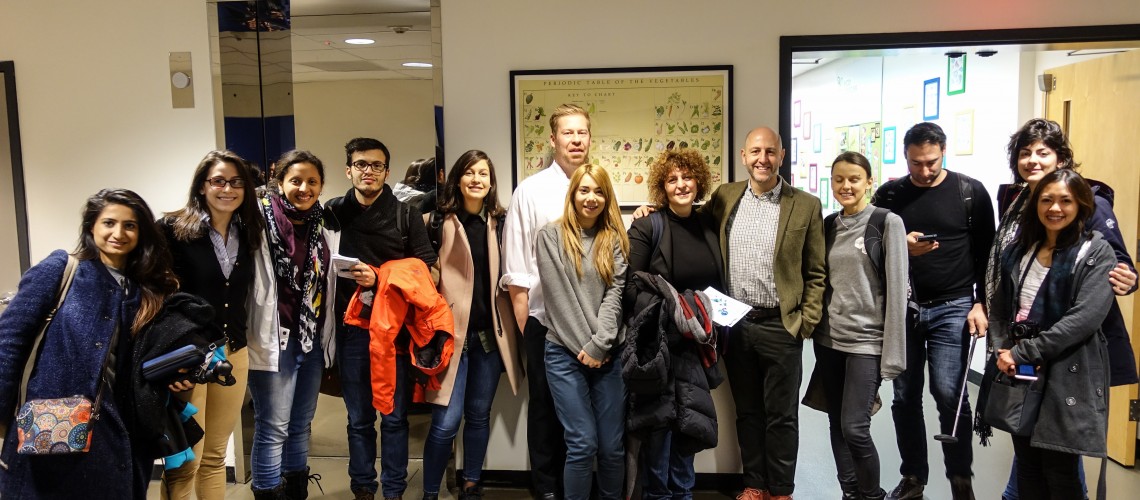
Edible selfies made of cookies, healthy but cool food, local food markets, and a network of always evolving startups. The city that never sleeps, especially when it comes to food experimentation. The trip focused on vertical farming, holistic food education (especially for children) and taking a global and diverse approach to food.
The trip to New York played out like a scene from a movie for the members of FIGM17, starting with a pastrami meal straight from the same restaurant where “When Harry Met Sally” was filmed. Among the food rituals experienced was a Food + Tech Meetup, a networking opportunity to bring together lovers of food and innovation alongside food startuppers and tech people, all organized by Food + Tech Connect founder Danielle Gould. During the time in New York, the talents of the Food Innovation Program were able to attend a meeting with farmers from the Young Farmers network, who are working to make the American food system more sustainable. They also encountered the creators of Edible Selfiee, a startup that can print selfies on food in real time. Also inspiring for the students were the many entrepreneur stories, especially that of Mona Safabakhsh of Dig In who talked about how to bring products from local farms to restaurants. Kerry Sesil of Grey Bakery explained about the mission of Open Hiring and Seth Syberg of Cocoburg talked about creating a tasty new vegan snack with a coconut base. To conclude the evening was a networking aperitivo organized by Italian entrepreneur and startup expert Paolo Privitera on the fifteenth floor of Mr. Purple, a great spot with a perfect view of Manhattan.
The attention to education and research institutes focused primarily on universities during the Boston leg, but in reality concentrates on every level of education. A visit to Phillips Academy Charter School, an elementary and middle school also visited last year by former First Lady Michelle Obama (always attentive to the theme of healthy eating), allowed FIP students to see the school’s rooftop garden used to teach sustainable agriculture methods with the help of Eco Spaces, a program using a holistic approach in connecting social, environmental and nutritional aspects of eating. The chef, director of the project and food hero Robert Wallauer personally met the delegation alongside director Frank Mentesana to explain how the school menu is created for the students using products they themselves cultivated in the garden. The Phillips Academy Charter School is considered a pilot institution that was among the first to embark on this type of program, but is now replicated in many schools around New York and New Jersey. As director Mentesana explained, the main goal is to promote food literacy education: food education that creates valuable connections between kids and food at various levels by understanding the cultivation and preparation of food. The program is also linked to Michelle Obama’s “Let’s Move” campaign.
So how is it possible to grow vegetables on the roof of a building in city center? Thanks to advanced researched and new indoor vertical gardening techniques developed by a leader in the field who is revolutionizing agriculture: AeroFarms Technology, who the FIP students visited at their headquarters in Newark. Stephen Ritz of Green Bronx Machine is also impacting food education through his project to create healthier and happy kids in the Bronx with a well-rounded approach that is linked to increased school attendance and positive results for the involved children and their families.
New York, the cosmopolitan city, showed the delegation its ability to host many ethnicities and foods of the world. In fact, for the Chinese New Year, which welcomed the year of the Rooster on January 28th, the delegation visited a show called “Chow” at The Museum of Food and Drink (MOFAD) which “celebrates the birth and evolution of Chinese American cuisine, tracing its incredible 170-year history and sparking conversation.” The executive director and show curator Peter J. Kim talked to students while showing them some menus from 1910 and highlighting how the particular Chinese American gastronomic tradition should not be considered “fake” Chinese food, but instead as an autonomous culinary identity. Another interesting display was a machine to make fortune cookies in the museum kitchen that had inside personalized messages sent through the internet from people around the world. Finally, a look inside an enormous tent made from traditional Chinese take-away boxes.
Another important visit in order to understand the variety of products made from recipes taken from around the world was to Union Square Market, situated in the center of Manhattan where the best producers come together on Sundays to sell their products. In this journey around the world in search of the hot spot cities for food and innovation, each moment is an occasion to make a new discovery, just as a “simple” pizza like that from Ribalta by Napoletano chef Pasquale Cozzolino allowed for a better understanding of 3D printing of food with the help of BeeHex. And for who is more interested in healthy food, it was a great opportunity to see the inside of Whole Foods Market, one of the largest health food stores in the city.
Follow this amazing lifetime experience “live” on Facebook, Twitter, LinkedIn, YouTube and Instagram using the hashtag #FIGM17
© 2015 Food Innovation Master Degree | © 2014 FUTURE FOOD INSTITUTE
